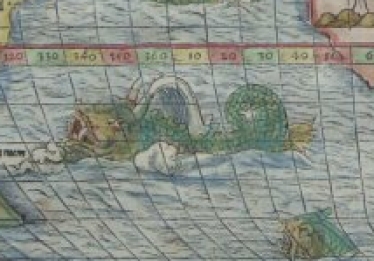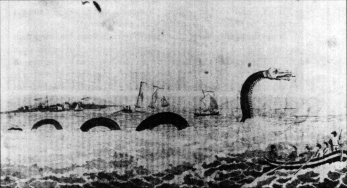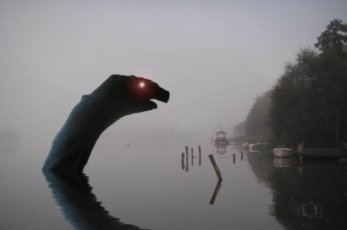I love old maps. Maps used to be full of monster drawings, especially pre-17th century ones created for the upper class. Cartographers weren’t just trying to dazzle people–they were trying to educate them, and illustrated creatures based on real sailors’ reports. Why is it, then, that so many include a beast like this?

You know, the one with the humps?
This full moon, let’s take a look at a specific example of one of these serpentine horrors: a Loch Nessian-style monster right here in the U.S.
Flathead Lake sits in northwestern Montana, and is the largest lake in the contiguous U.S. west of the Mississippi. It’s nearly 30 miles long and 15 miles wide, and can get up to 370 feet deep (over 34 stories). In short, it’s a lot of water. 75 million years ago, Flathead Lake was actually an inland sea, one full of sharks and the aquatic reptiles of the dinosaur era. Some people–lots of people: lawyers, doctors, policemen, engineers, biologists; locals and non-locals alike–say that not all of those monstrous species have left.
Take Julia and Jim Manley, who had considered themselves skeptics of the strange sightings. One beautiful, breezeless summer day in 2005, they went out on it in their boat to enjoy the water. When they tried to go home, their engine wouldn’t start. The battery was dead. They were stranded out in the open lake, with not a single other soul in sight.
Anxious, they called their daughter, hoping that she could come rescue them. She said she was on her way. But as the Manleys settled in for their wait, they heard a loud, heavy slap against the water. They heard the sound again–it was close, worryingly close. Then they looked over the side of their boat and saw it.

Like this, maybe, only the monster’s head wasn’t showing and also it was 2005.
There were black, sinuous humps slithering through the waves–a giant chain at least as long as their 24-foot boat. As they stood in horrified silence, they saw something else coming at them over the horizon: their daughter’s boat. The monster slipped away into the water before she could see it, and the Manleys realized that now they were the ones who would have to convince those skeptical of the monster of Flathead Lake.
Consider this combined with with the accounts people have shared of schools of fish jumping out of the water, as if fleeing a massive predator. Or the account of a man’s fishing nets having enormous, unexplainable holes in them. The account of the fisherman whose boat was violently rocked by a “monstrous shadowy shape.” The account of the 3-year old that fell in the lake, and when asked how he survived, said “the Flathead monster lifted me up.”

Legit.
The first Flathead monster sighting recorded in writing was in 1889, when 100 steamboat passengers saw the beast and someone freaked out and shot at her. Before that, there was a Kutenai legend that involves a giant monster breaking through the lake ice and drowning half the tribe. All accounts are surprisingly consistent, in spite of people not knowing each other and outsiders not knowing what might be in the lake. “Flessie” (as the locals call her, a play on the very similar “Nessie” of Loch Ness) is between 20 and 40 feet long, eel-like, with dark brown or blue-black skin and dark eyes. Sighting reports roll in at a rate of about 1 to 2 per year, with 92% occurring between April and September.
The only time this varied was in 1993, when there were a whopping 13 sightings, some within 20 minutes of each other. With how big the lake is, that temporal proximity leaves us with a few possibilities: a) someone is lying, b) someone saw a log, or c) there might not be one Flathead Lake monster, but two.
Some reports say that nearly all people local to Flathead Lake have seen Flessie at some point; others say that there are fisherman that have been out on the water for decades without catching so much as a ripple. Regardless, the monster has been around for a long time, and doesn’t seem to be going away. Skeptics blame sightings on everything from a dead monkey to an escaped buffalo, but belief persists. Many who come forward to share their stories have been reluctant to do so, not wanting to seem crazy, but needing to share their story with someone. Perhaps it is to all of our benefit that they do.
You never know when it might be important to know where there’s a monster on the map.
What’s your favorite water-based cryptid? Share your thoughts in the comments below.
All images are courtesy of Wikimedia Commons. See map image here; old-timey illustration here, and glow-in-the-dark eyeballs here. Featured image by Paul Johnston on Unsplash.





0 Comments